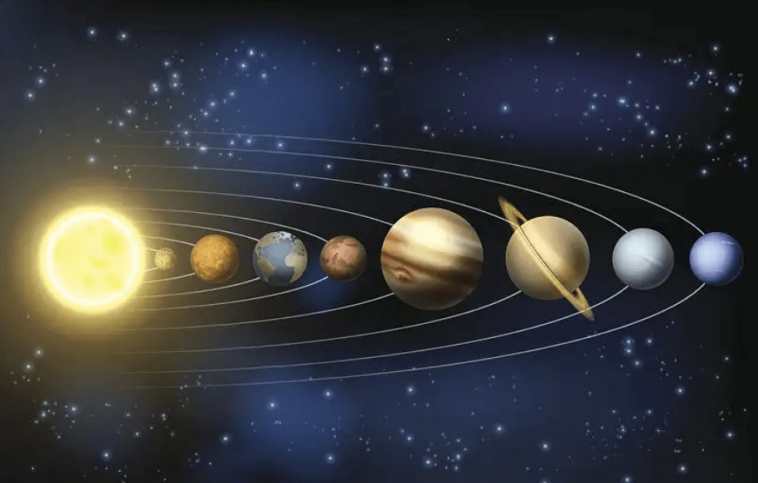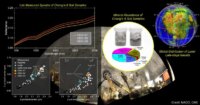Since the first ancient human being looked at the vast sky, human civilization has embarked on the path of pursuing the mysteries of the universe.
On this tortuous and long road of cognition, countless astronomy masters were born, and many research events extended, especially religious sanctions and persecution, which almost brought astronomy to destruction.
The earliest cognition of celestial bodies: the theory of flat earth
In fact, at the beginning, human beings’ understanding of cosmic celestial bodies was very limited and extremely unscientific, because most ancient civilizations believed that the earth on which human beings lived was a flat body, not a sphere.
For example, in ancient Indian civilization, the Indians proposed that the earth is a disc supported by elephants, which means that the reason why celestial bodies move is that the elephants are in essence, which makes us feel the earth itself The change.
As for why it has to be an elephant instead of other creatures and objects, this mainly stems from the worship of the Indian object god. Therefore, it is not difficult for us to find that the earliest celestial cognition and religion in ancient India are related.
In addition, another ancient civilization, Egypt, believed that the earth is a flat disk surrounded by a water circle, just like the common decoration “snow ball” that people use today.
This kind of cognition does sound a bit “outrageous” to modern people, but in the cognition of ancient Egyptians, it is real science.
Because people at that time believed that there was rain on the earth, which meant that there must be water on the periphery of the earth, otherwise where would the rain come from? Secondly, the area where Egypt is located is very flat, which makes the Egyptians think that the earth is a huge plain.
Finally, the Egyptians were good at using discs to draw and record events, so when explaining the shape of the earth, they added this national and artistic factor into it, forming a unique understanding of the earth.
Similar to this, there is also the description of the earth by the ancient Babylonians: “a square chessboard surrounded by sea water”, which is actually a standard expression that combines national culture and weather.
Speaking of this, some people may bring up the “round sky and place” in ancient China, and think that ancient China was also a civilization that firmly supported the flat earth theory.
But it should be noted that the word “sky round place” does not express the concept of flat earth, but the philosophy of Yin Yang School, that is, the sky and circle symbolize movement, and the earth and square symbolize stillness. Tonic, balance of yin and yang” thinking.
Moreover, Zeng Zi, a famous Confucian master in the late Spring and Autumn Period, once said: “If the sky is round and the earth is round, the four corners cannot be hidden.”
This sentence is interpreted in vernacular Chinese, which means: If the sky is round and the earth is square, then the square corners of the ground will not be completely covered.
From this, it is not difficult to see that the study of celestial bodies in ancient China is extremely concise, specifically, it is divided into model concepts, philosophical concepts, and a meteorological observation.
It’s just that with the development of later generations, the discussion of philosophical concepts is relatively backward, while the concept of models and meteorological observations are relatively advanced. The concrete embodiment of the “model concept”.
However, the ancient Greece on the other side of the world is just the opposite of us. Their research on celestial bodies is the most prominent philosophical concept.
Aristotle: Center of the Earth says
In the sixth century BC, the famous ancient Greek mathematician Pythagoras put forward the “circle of the earth” for the first time after rigorous celestial calculations, that is, the place we live in is actually a sphere. The Origin of the Earth Concept”.
However, Pythagoras did not convince the world with practical and popular examples. His cognition mainly stayed at the stage of academic discussion, and it was not until the appearance of Aristotle that the theory was further developed.
Compared with Pythagoras, Aristotle is a young man, but he is also a great rising star. He studied under Plato and has profound attainments in the field of philosophy.
Therefore, after understanding Pythagoras’ academic cognition, he started a lot of thinking and summed up three specific methods that can verify the “round earth theory”.
The first is “the further north you go, the higher the North Star”, the second is “the further south you go, the lower the North Star”, and the third is “in the south, you can see stars that you cannot see in the north”.
To a certain extent, these three theories explain that the earth we live in has a curvature, otherwise, how could there be a huge height difference on the same plane, and even the “shading” effect of the sphere?
But it is worth mentioning that although these definitions of Aristotle seem very reasonable today, they were somewhat unreliable at the time.
The first is the height of the Polaris. You must know that it is difficult for human eyes to accurately perceive subtle height differences. What’s more, in ancient Greece, the height of the Polaris could not be estimated by the naked eye.
Therefore, Aristotle’s theory was not substantively proved until Magellan sailed around the world. After all, the distance around the world is enough to reflect the height difference of the Polaris.
However, the theory proposed by Aristotle is not limited to the “round earth theory”, he also put forward the absurd “earth center theory” from a philosophical point of view.
The geocentric theory, as the name suggests, means that the earth is the center of the universe and is stationary. Obviously, this theory is very outrageous in today’s view, until the Polish astronomer Copernicus further rewritten it as “heliocentric theory”.
The heliocentric theory was put forward thousands of years after the geocentric theory. At that time, after careful observation, Copernicus discovered that the stars, including the earth, were actually in a state of motion, and the stars seemed to revolve around the sun.
This means that the geocentric theory may not be scientific, and the actual center point should be the sun, but religion has created countless deified statements on the basis of the geocentric theory, so Copernicus’ heliocentric theory has threatened the dominance of religion to a certain extent .
Therefore, Western religions have brutally suppressed this theory. For example, Bruno, a supporter of this theory, was burned to death at the stake by the church, which was quite tragic.
Fortunately, after Galileo used astronomical telescopes to observe, he proved Copernicus’ heliocentric theory, confirming that the sun may be the center of the stars.
Of course, based on the backwardness of equipment and theory, Copernicus’ heliocentric theory also has some errors. For example, he believed that the orbiting motion of stars is circular, but this does not match the actual motion.
Later, Kepler conducted a series of rigorous observations based on this definition, and finally found that the orbiting motion of stars is actually an elliptical trajectory. This made the heliocentric theory officially mature and accepted by later generations.
However, most of these are the results of observations. As for why the stars undergo such orbital rotation, people at that time did not have a specific conclusion.
Until Newton proposed the “Law of Universal Gravitation”, proving that everything has gravitational force, the reason why the stars will move around is due to the sun’s gravitational force on the stars, and this has also formed today’s human cognition of celestial bodies.
From this, it is not difficult for us to see that the exploration of celestial bodies is extremely difficult and long, and it is not easy for human beings to come to this day.
However, it should be noted that, as mentioned above, human cognition is constantly improving, which indicates that with the continuous advancement of science and technology, there will be new breakthroughs in human cognition of celestial bodies.
At that time, people after the breakthrough will look at our cognition today, and it may be the same as Copernicus looked at Aristotle, which has drawbacks and is very unscientific. The only way.



GIPHY App Key not set. Please check settings